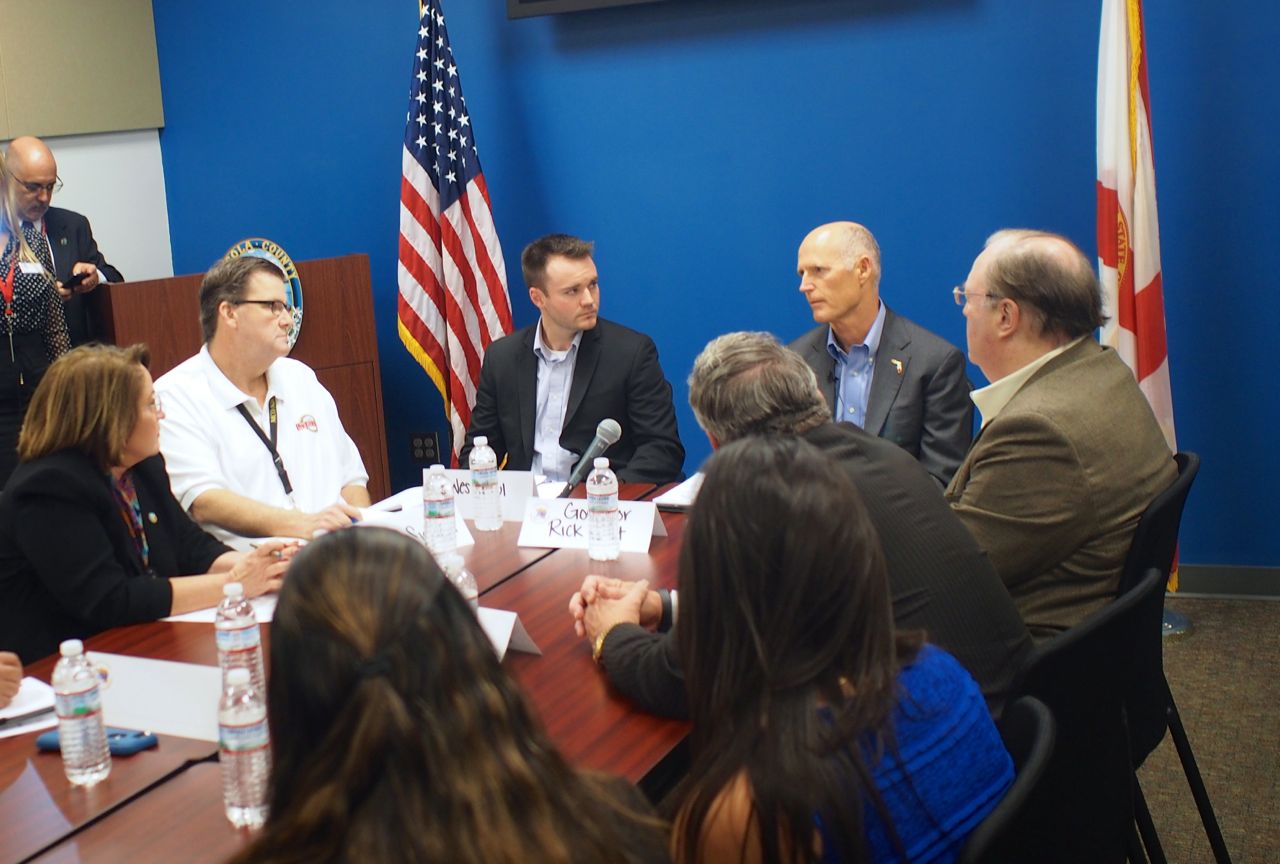
The influx of Puerto Ricans evacuating their devastated homes in Puerto Rico are beginning to test the capacities of Central Florida and in particular Osceola County, and more state coordination is needed, a group of local officials told Gov. Rick Scott Monday.
Those officials, including Kissimmee Mayor Jose Alvarez, Osceola County Schools Superintendent Debra Pace, and Orange County Mayor Teresa Jacobs, told Scott during a roundtable meeting in Kissimmee Monday morning that they want to do all they can to help Puerto Ricans displace by Hurricane Maria but they expect to reach their limits, as Central Florida appears to be the first-choice of most of the more than 143,000 who’ve come to Florida already.
The problem is that evacuating people seek first to live with or near family they have stateside, and that means concentrated communities in South Florida, the Tampa Bay area, and the State Road 417 corridor through Seminole Orange and Osceola counties of Central Florida. While so far the vast majority of evacuees appear to be finding places to stay, mostly with families, officials are expecting an already-existant housing shortage to become a crisis. And certain schools already are crowding.
More than 6,300 children from Puerto Rico have enrolled in Florida schools since Hurricane Maria, following the pattern of their evacuee parents into communities that already have large Puerto Rican populations.
“We have 1,352 new students from Puerto Rico specifically from Hurricane Maria, and an additional 100 from the other storms,” Pace said.
That’s the equivalent of two full elementary schools of new students who arrived in a few weeks. And more are on the way, as some projections exceed 300,000 for the number of Puerto Ricans likely to relocate to Florida. Osceola schools already were peaking beyond projections before Hurricane Maria, Pace said.
“We’re welcoming them and doing all we can to serve them. But capacity is becoming a true issue: teacher needs, staffing to help support them,” Pace said. “And as you notice the conditions down there are not good, so the children are stressed. The families are stressed. It is really taking an emotional toll as well to educate them as well as to love them.”

The dilemma is created because the existing large communities of Puerto Ricans in Florida are where the evacuees are most likely to have family and friends who can offer them spare bedrooms, couches, and a few hot meals. But if they want to stay, and indications are most are expecting to stay, that’s a temporary situation that would last only a few months, and then the housing shortage and jobs pool will become bigger factors.
Housing is the next big challenge, Alvarez predicted. He made a couple of suggestions, including the placement of FEMA trailers, and the possibility of converting closed motels in the U.S. Highway 192 corridor into FEMA housing.
“We need to look at how we are going to get that resolved before that becomes a problem,” he said.
And the schools already are experiencing the imbalances, as Pace described.
“If they want to stay in Central Florida, which is a logical thing for them to want to do, even if we brought in housing, our schools may not be able to handle it,” Jacobs said. “So that’s why we’ve been looking to see if FEMA has a broader approach if we need it.”
 Jacobs had written to Scott, the Federal Emergency Management Agency and Florida Division of Emergency Management two weeks ago, along with the chairs of Osceola and Seminole counties, urging a meeting such as the one Monday be set up to examine how the federal, state and local authorities could plan long term and coordinate more closely to try avoid service capacity issues by overwhelmed areas, while other areas of the state might have plenty of housing, school capacity and jobs going untapped.
Jacobs had written to Scott, the Federal Emergency Management Agency and Florida Division of Emergency Management two weeks ago, along with the chairs of Osceola and Seminole counties, urging a meeting such as the one Monday be set up to examine how the federal, state and local authorities could plan long term and coordinate more closely to try avoid service capacity issues by overwhelmed areas, while other areas of the state might have plenty of housing, school capacity and jobs going untapped.
In addition to providing relief resources to the island of Puerto Rico, Scott has coordinated a number of efforts in Florida to assist evacuees, starting with the creation and opening of welcome centers at the Miami and Orlando international airports which have helped direct more than 26,000 evacuees and their families toward housing, food, transpiration, education, job placement, and other services, and, last week, directing the Florida Division of Emergency Management to activate the State Emergency Operations Center to Level 2, to better coordinate transitional housing.
“The biggest thing is to figure out how we go forward,” Scott said. “We’re going to continue to have housing, education, jobs, we’ll have all these issues.”
Jacobs said she heard what she hoped to hear.
“This addresses the need for a meeting, absolutely,” Jacobs said. “We were very pleased.”


